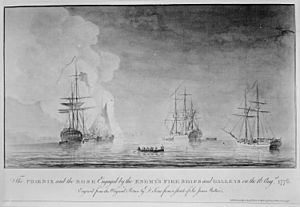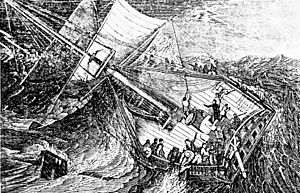HMS Phoenix (1759) facts for kids

This picture shows the Phoenix and the Rose fighting enemy ships in 1776.
|
|
Quick facts for kids History |
|
|---|---|
| Name | HMS Phoenix |
| Ordered | 5 January 1758 |
| Builder | John & Robert Batson, Limehouse |
| Laid down | February 1758 |
| Launched | 25 June 1759 |
| Completed | By 26 July 1759 |
| Fate | Wrecked 4 October 1780 |
| General characteristics | |
| Class and type | 40-gun fifth-rate frigate |
| Tons burthen | 84267⁄94 bm |
| Length |
|
| Beam | 36 ft 9.75 in (11.2205 m) |
| Depth of hold | 15 ft 11.5 in (4.864 m) |
| Sail plan | Full-rigged ship |
| Complement | 280 |
| Armament |
|
HMS Phoenix was a powerful 44-gun warship of the Royal Navy, Britain's navy. She was built in 1759 and served during the American War of Independence. Sadly, she was lost in a terrible storm in 1780.
Contents
Building and Launching the Phoenix
The Phoenix was launched in 1759. Her first captain was Prince Edward, Duke of York and Albany, who was a member of the royal family.
Phoenix in North America
The Phoenix played a role in the American War of Independence. She was commanded by Captain Hyde Parker, Jr.. By June 1776, the ship was near Sandy Hook, New Jersey, with other British ships.
Later that month, the Phoenix captured at least three American ships. She also stopped an American attack on a lighthouse near Sandy Hook. In July 1776, the Phoenix, along with the Rose and Greyhound, moved towards Red Hook, Brooklyn. They anchored near Gravesend, Brooklyn.
On July 12, 1776, the Phoenix and the Rose, along with three smaller ships, attacked New York City. The British ships easily passed American defenses. They then fired cannons at New York for two hours. This showed the American colonists that the British Navy could attack deep-water ports easily.
The Phoenix kept bothering American positions along the Hudson River. She stayed there until August 16, when she returned to Staten Island. Maps from that time show the Phoenix and Rose south of Manhattan again. In February 1777, the Phoenix captured two more ships near Cape Henry. One of these was a schooner called the Betsy.
Economic Warfare: The Phoenix and Fake Money
The Phoenix was also involved in a different kind of fight: a currency war. During the Revolutionary War, the American government printed paper money called continental currency.
As early as January 1776, people on the Phoenix started printing fake $30 bills. This operation continued until at least April 1777. These fake notes could be bought for the cost of the paper they were printed on. This made it harder for the American colonists to trust their own money. Inflation, which is when money loses its value, was a big problem for the Americans. By November 1779, prices were rising by 47 percent each month. The fake money from the Phoenix contributed to these serious money problems.
The Loss of the Phoenix
The Phoenix, still under Captain Hyde Parker, sank on the night of October 4, 1780. This happened during a huge hurricane that damaged many British ships in the West Indies.
Lieutenant Archer wrote about the storm on November 6, 1780. He said the sea was like "mountains" of fire. The wind roared louder than thunder. Strange blue lightning made everything even scarier. He described the ship shaking and groaning as it fought the storm. Before the ship sank, the crew cut down the mainmast after the storm broke it.
For three days, the crew worked hard to get supplies onto the shore of Cuba. At that time, Cuba was controlled by Spain, which was an enemy. Captain Hyde Parker ordered his crew to fix a small boat. He then sent it to Montego Bay in Jamaica to get help.
A rescue mission arrived with three fishing boats and later a larger ship called the Porcupine. They helped evacuate the survivors. The Phoenix lost 20 men when the mainmast fell during the storm. But the remaining 240 men reached Montego Bay safely on October 15.


